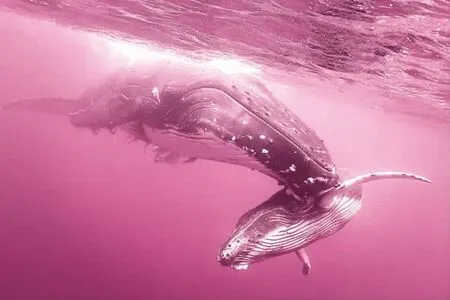静听鲸语
新疆 王向阳
疫情的爆发导致很多轮船无法正常航行,因此海面变得安静了,更为安静的环境为科学家们静听鲸语提供了难得的机会。

难词探意
1. humpback /'hʌmpbæk/ n. 座头鲸
2. hydrophone /'haɪdrəfəʊn/ n. 水中听音器
3. vocalize /'vəʊkəlaɪz/ v. 说(话);唱(歌);发声
When humpback whales swam to Glacier Bay in Alaska to spend the long summer days feeding, they arrived to something unusual: quieter waters.
“For long animals have been able to communicate over vast distances in the ocean. Once we introduce noise and increase sound levels,they won't communicate over those distances.Clearly there's going to be some impact there,”says Jason Gedamke, who manages the ocean acoustics program at NOAA Fisheries.
While many scientists have canceled field work this year because of the COVID-19 pandemic, which keeps more cruise ships docked and provides momentary relief for whales that are highly sensitive to noise, wildlife biologists in Glacier Bay National Park(GBNP)have kept it up by taking solo boat trips to track the humpback population. The data they collect to count and identify whales continue record-keeping that goes back 35 years.

These humpbacks are still recovering from a stretch of bad years when few baby whales were born. In the Pacific, warmer ocean temperatures dramatically harmed the food web. This year, the signs are more encouraging.
“They're really homebodies,” Christine Gabriele, a wildlife biologist says. “They go back to the same feeding spots year after year.”
But below the surface, Gabriele and her colleagues are learning far more with a hydrophone, continually recording the underwater soundscape. Humpbacks are chatty creatures.They use sound in almost every aspect of their daily life. Studying the underwater sound environment is really important because it helps to see the world the way the whales actually use it.
The whales also share Glacier Bay with cruise ships and boats, which are regulated to limit their numbers. When vessel noise is loud,Gabriele and her colleagues found that the whales have to accommodate it,a lot like people would at a loud party.
“In order to communicate with each other,they might have to be close together,” she says.“They might have to repeat themselves. Or they might have to wait for a quieter moment before they start vocalizing.”
But this year, boat traffic has been way down.“It's much quieter,” Gabriele says. “Just by listening to it you can tell.”
“The pandemic has created this unexpected opportunity for science, kind of a once-in-alifetime chance to look at whale communication behavior in its natural undisturbed form,”Gabriele says.

1. Why did the humpback whales swim to
Glacier Bay in Alaska?
A. To look for cleaner waters.
B. To enjoy the summer there.
C. To feed baby humpback whales.
D. To escape from being found and killed.
2. What can be inferred according to Para. 2 and Para. 3?
A. Noise has little influence on humpback whales' communication.
B. The outbreak of the pandemic made trade by sea less than usual.
C. Data collected to count and identify whales were a little disappointing.
D. Wildlife biologists in GBNP observed whales more during the pandemic.
3. What does the underlined word “homebodies”probably mean?
A. Those who love their home and like staying at home.
B. Those who act only within the scope of their home.
C. Those who return to their home from time to time.
D.Those who leave their home at an early age.
4. What does Gabriele think of the pandemic in
terms of her research?
A. Once in a blue moon.
B. A fence before the rain.
C. An item on the agenda.
D. The writing on the wall.

Difficult sentence
While many scientists have canceled field work this year because of the COVID-19 pandemic, which keeps more cruise ships docked and pro vides momentary relief for whales that are highly sensitive to noise, wildlife biologists in Glacier Bay National Park(GBNP) have kept it up by taking solo boat trips to track the humpback population.
【翻译】_______________________________
【点石成金】本句中While引导的是一个让步状语从句,在句中意为“尽管”;which引导的是一个非限制性定语从句, 先行词为the COVID-19 pandemic;that 引 导 定 语 从 句,先行 词 为whales。 wildlife biologists in Glacier Bay...humpback population为句子的主句部分。

冰川湾国家公园(Glacier Bay National Park)
冰川湾国家公园(Glacier Bay National Park)占地330万英亩,园内有崎岖的山脉、动态的冰川、苍翠和繁茂的温带雨林、天然的海岸线和深深的海湾,是阿拉斯加的一个亮点。 该公园是世界自然遗产之一,也是世界上最大的国际保护区之一。
1794年,英国航海家温哥华乘“发现”号来到艾西海峡时,还没有冰川湾。 他所看到的只是一堵16公里长、一百米高的冰墙。 但是85年后美国博物学家约翰·缪尔来到此地,他发现的是个广阔的海湾。冰川已向陆地缩回了77公里。现在,在冰川湾国家公园里,冰蚀的峡湾沿着两岸茂密的森林,伸入内陆一百公里,尽头是裸露的岩石,或是从美加边境山脉流下的16条冰川中的某一条。 高高的山峰远远耸立在地平线上,俯瞰这片哺育冰川的冰雪大地,其中最高峰是海拔4,670米的费尔韦瑟峰。

